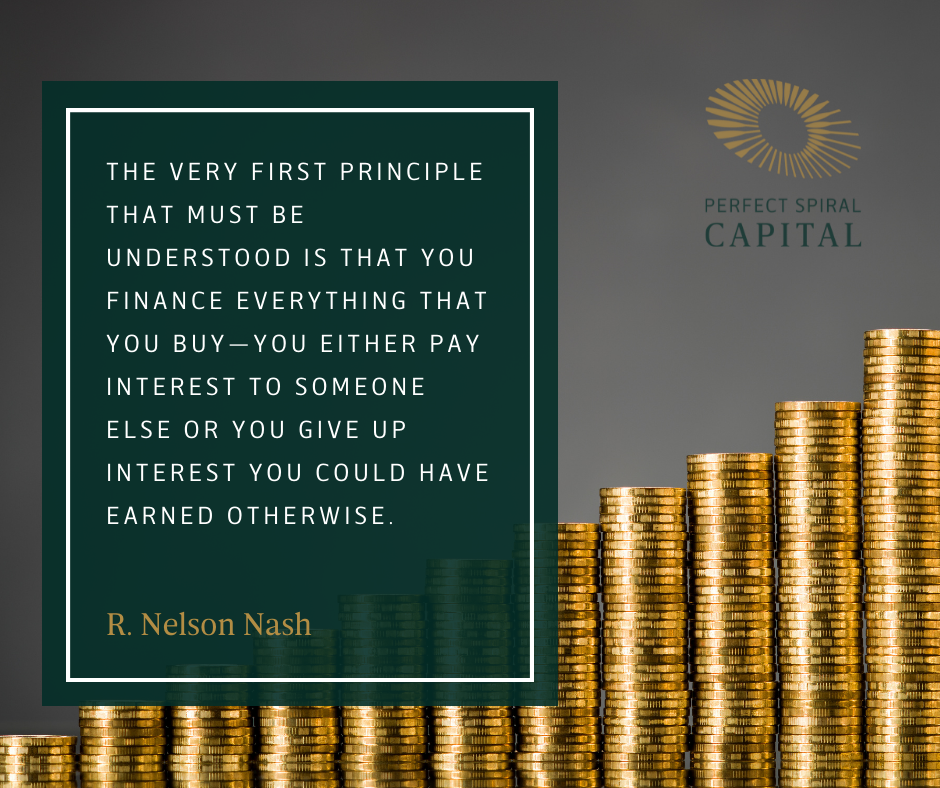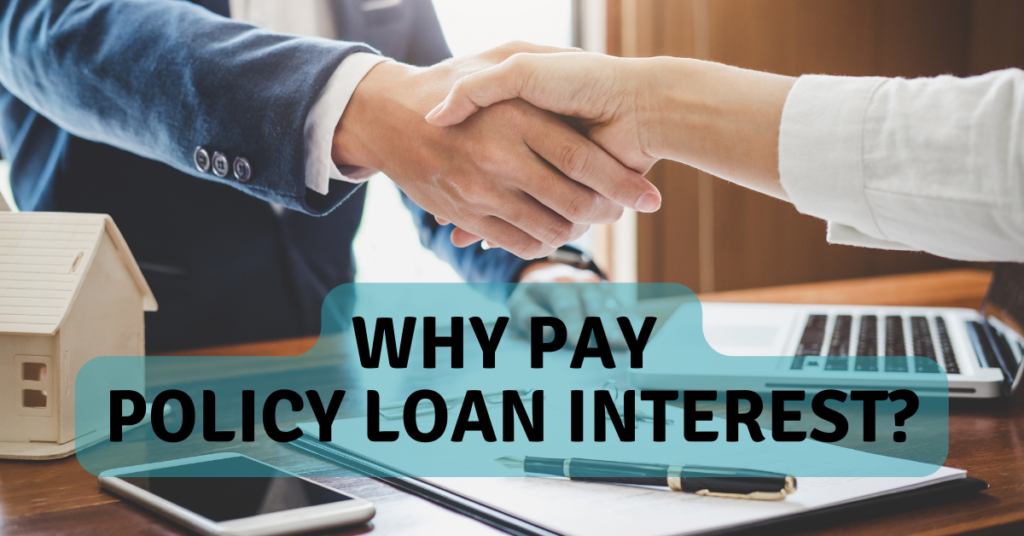Perhaps the most common objection to using a dividend paying whole life insurance policy as a platform for your finances is this: “Why should I pay policy loan interest? It seems stupid to pay interest to use my own money! After all, if I just pay cash for everything, I don’t have to pay anyone an interest rate at all!“
Let us start this analysis by quoting R. Nelson Nash, upon whose work I base my entire business:

– R. Nelson Nash
Are there really only two options here? Let’s examine this more closely.
Paying Interest to Someone Else
This is the most familiar place for most individuals in the United States to start. For simplicity, I will use round numbers, and eliminate considerations like sales tax, which only complicate the examples and make it harder to see the underlying principles.
Let’s say you want to buy a used car with no down payment, for $10,000. According to Cars.com, that means if you financed for 60 months at 10% APR, your payment would be $212 per month. At the end of the 5 year period, you would have paid $12,748 in total; $10,000 in principal in $2,748 in interest.
It’s plain to see that your “fee” for spending money you didn’t have would be $2,748 of future earnings. That is not just 10% of the original purchase price. That is an interest rate over time: In this case, it is actually 27.48% interest! (Or, thought of another way, 21.56% of the total amount paid would be interest.)
Retail credit cards are even worse. Buy $10,000 of appliances and furniture on a “store card” from a major retailer, and you are likely to see an interest rate more like 25% APR. Pay this back over the same 60 months, and your total interest payments would be $7,611. Check my math, here! That’s not 25% interest. It’s 76.11% interest! (43.22% of the total amount paid would be interest!)
APR is a misleading term. APR stands for Annual Percentage Rate, but as you can see that is not a simple interest rate. If you want to learn more, it is actually calculated according to this formula.
Despite this, people are generally taught to just focus on the monthly payment, rather than the total volume of interest. When my wife and I grew tired of playing this game, we went to an “all cash” strategy. But, we were still missing a major piece of the puzzle!
Giving Up Interest
Let’s say, again, that you need to buy a car for $10,000. This time, there is no bank, no finance company, no credit card. You have $10,000 in the bank. They won’t give you that much in physical cash, so you get a cashier’s check. You give the cashier’s check to the dealership, and the deal is done. No interest payments!
Right?
I know it looks that way, but there is an interest rate at work here.
What is an Interest Rate?
To fully understand this, we need to back up and examine what an interest rate is.
Stated simply, interest is the price of time.
In our earlier examples with the auto finance company and the credit card company, they are granting you access to money now, in exchange for payments over time. I chose 5 years (60 months) for the examples, but it could be any length of time.
If, for example, you agreed to pay the car loan back in 24 months instead of 60, what happens? Your payment goes up, but the total volume of interest goes down.
Logically, this makes sense. If you pay the loan off more quickly, the lender doesn’t have to wait as long to make another loan. It’s little more than an exercise in considering the other side’s point of view.
The lender, being in the business of payments over time, is acutely aware of the time value of money.
Thus, the longer it takes you to pay back the loan, the more interest the lender must charge on the interest. That is why interest “compounds.” A loan of $10,000 at 10% is only $11,000 after the first year with no payments. But the second year, the 10% interest rate is applied to the entire $11,000 balance.
If no payments are made for a long time, compounding can become a big issue for the debtor:
- $10,000 to start
- $11,000 at the end of year 1
- $12,100 at the end of year 2
- $13,310 at the end of year 3
- $14,641 at the end of year 4
- $16,105 at the end of year 5
- $174,494 at the end of year 30
If that’s money that you owe, that starts to look a little scary!
But What Does This Have to Do with Paying Cash?
What was missing from our hypothetical scenario of buying a car in cash? If you answered “time,” you are already miles ahead of your peers!
When you pay cash, it is tempting to forget about time. But it took you time to save the money! And, if you spend all $10,000, it will take you time to save up the next $10,000 for the next car. Not to mention, of course, that a similar car won’t be $10,000 in several years—thanks to the hidden tax of inflation!
Giving Up Interest Revisited
Let us go back to our cash example. You have $10,000 and want to spend it all on a used car. Meanwhile, there is an opportunity to earn a compounding interest rate of 5% elsewhere with the same $10,000. Let us also say it would take you 5 years (60 months) to save $10,000 again from your regular paycheck.
We must first calculate the value of $10,000 compounding at 5% over those 5 years:
- $10,000 to start
- $10,500 at the end of year 1
- $11,025 at the end of year 2
- $11,576 at the end of year 3
- $12,155 at the end of year 4
- $12,763 at the end of year 5
Can you see that spending $10,000 cash today is really spending $12,763?
You can’t earn the additional $2,763 because you have effectively traded it for the car.
Besides, what do you think the car dealership is going to do with the cash you paid them? They are going to use it to earn more money. Why didn’t you?
“No Interest” Financing
Before we return to the question of policy loan interest, there is a brief (but highly instructive) aside I would like to make.
Everyone, at some point, has seen an advertisement for “interest-free” financing. If the preceding paragraphs have not already made this crystal clear, let me just say plainly: There is no such thing.
Capital bears a “time price,” period. If a $10,000 item has “no interest” for 60 months, that is not a $10,000 item. If you take the financing package, it’s effectively a (roughly) $6,209 item at a 10% annual interest rate for 5 years. (Or, some other price with some other assumed interest rate that yields a $10,000 price in 5 years.)
If you pay $10,000 in cash for such an item, the seller immediately profits roughly $3,791 if we use my (completely arbitrary) numbers. That means the seller can immediately purchase more merchandise to sell to people who do not understand this, at “no interest!”
Always press for a cash discount in a situation like this. If none is available, go elsewhere!
Paying Policy Loan Interest
Finally, let us return to the idea of paying policy loan interest when fully utilizing your whole life insurance contracts.
Let us again use the same numbers: Your policy has $10,000 in cash surrender value. This is available, as stipulated in your contract, for you to access via a policy loan.
If you do this, you are taking a loan from the insurance company on the side—no money actually comes out of your policy. The collateral on the loan is the death benefit that the same company owes you when you die at some point in the future. The insurance company charges a low rate of interest. (This has nothing to do with your credit score! The insurance company does not care if you pay the loan back!) For simplicity, let us again use 5%.
Your outstanding loan balance will compound at 5% per year. Remember, though, that our car finance company in the first example was charging 10% APR. This situation has a number of advantages over any of the other payment methods in this article.
Advantage #1
The interest rate is low. 5% compounding may not look like that much of a savings, but remember our calculation above assumed no payments at all for 5 full years. Policy loan interest rates are generally similar to the rates charged to major corporations for their projects, and you have guaranteed access to these loan rates, no matter what your credit score or employment situation is!
Advantage #2
Cash values in your policy earn dividends, when declared by the insurance company. If your policy is with a non-direct recognition company, you earn the same dividend rate, even when you have a loan outstanding.
If you use your dividend to buy Paid-Up Additions (PUAs)—which are small “extra amounts” of insurance inside your policy—you are effectively compounding your money: Dividends mean PUAs, PUAs mean even more dividends! Repeat this a few years and the growth can be quite substantial.
Again, this happens even when you are buying other things: a car, a kitchen remodel, trading stocks, anything! The company will never ask you what the money is for.
Advantage #3
By paying the policy loan interest, you are contributing to the earnings of the company.
Since a mutual life insurance company is owned by its policyholders, paying the policy loan interest helps the company pay strong dividends, reinforcing the previous point even further.
Advantage #4
What about the extra 5% interest spread in Advantage #1? Buy even more PUAs. Almost every single dollar you pay into PUAs shows right back up in loanable cash value!
Nelson Nash would tell you this: Pay the payment you would have paid to the car finance company!
You will pay off your loan from the life insurance company very quickly, and then your remaining payments will buy you even more compounding growth for your future finance needs!
Used in this way, your policies will likely be buying cars for you in the future—all because you had the patience and foresight to stop “playing the game” with normal loans.
Advantage #5
Last, I want to highlight the incredible flexibility of policy loans. If you can’t make your payments, the life insurance company doesn’t care! They don’t make you sign any agreement about when or how often you will make payments. Lost your job? The loan is accruing interest, but you can pay it off whenever you have income again.
Review
Properly understood and utilized, your dividend-paying whole life insurance policies from a non-direct mutual insurance company will:
- Increase in cash value every year, guaranteed.
- Earn a dividend, when declared.
- Provide a place to put your windfalls (as PUAs, or to repay existing loans)
- Also earn guaranteed annual growth in cash values of PUAs
- Also earn dividends on PUAs.
- Provide for quick, easy, guaranteed access to funds through policy loans.
- Pay the full dividend, even when money is loaned out.
- Never decrease in value. (Pay back a $10,000 loan, and you can loan it back out soon afterwards! Your account doesn’t “drop to zero” like a bank account!)
- Get more efficient every single year.
- Never generate any tax liability.
All of the above examples were just talking about financing things that cost you money. Just consider for a moment how effective it is to use this method for something that earns you money! (Rental properties, stock market investments, whatever you like!)

